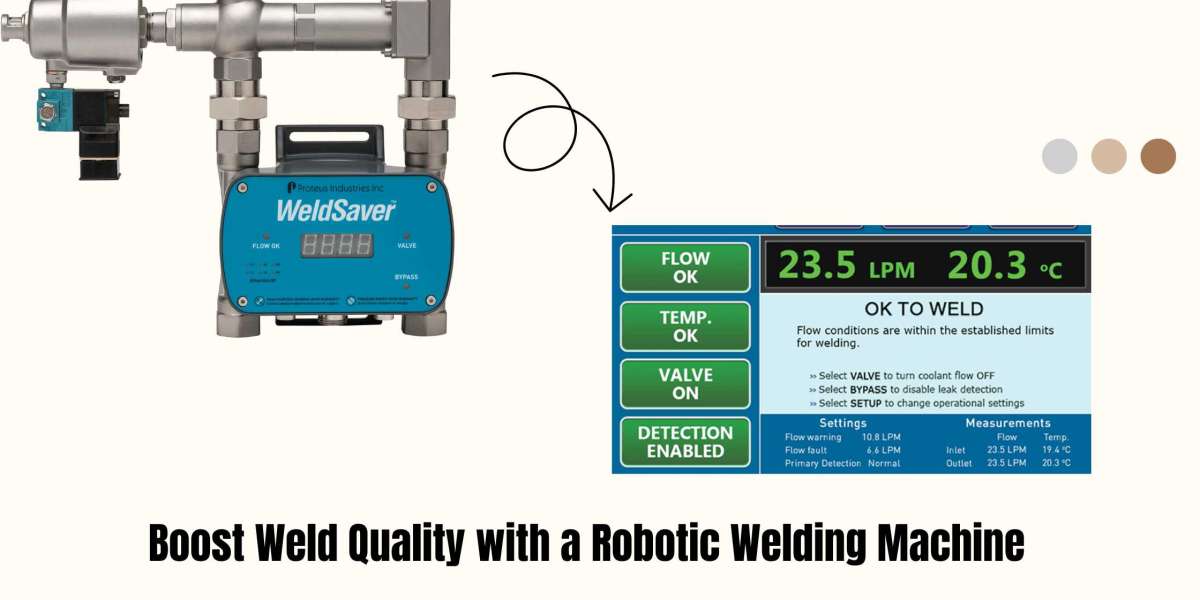Welding is crucial in various industries, requiring precision, consistency, and efficiency. Traditional welding methods often pose challenges like human error, inconsistent weld quality, and increased labor costs. This is where a robotic welding machine revolutionizes the industry, offering unparalleled accuracy, speed, and repeatability.
A robotic welding machine automates the welding process, ensuring uniformity in welds while minimizing defects. These machines integrate advanced sensors, real-time monitoring, and automated adjustments to maintain optimal welding conditions. One such innovation is WeldSaver, a cutting-edge coolant flow monitoring and leak detection system that enhances robotic welding performance.
By implementing a robotic welding machine, industries like automotive, aerospace, and heavy equipment manufacturing benefit from reduced downtime, improved safety, and higher production efficiency. This article explores how robotic welding enhances weld quality, increases productivity, and ensures long-term cost savings, making it an essential tool for modern manufacturing.
Understanding Robotic Welding
At its core, robotic welding is an automated process that uses robotic arms to perform welding operations with minimal human intervention. These robotic systems are programmed to execute precise welding tasks, ensuring consistency and efficiency. What is robotic welding, and how does it work? Simply put, robotic welding integrates advanced sensors, controllers, and software to streamline the welding process, reducing errors and improving productivity.
How Does Robotic Welding Work?
To understand what robotic welding is and how it works, we must break down its working mechanism:
- Programming the Robot - Operators use software to input welding parameters, defining the weld's path, speed, and angle.
- Material Handling - The robotic arm positions the workpiece accurately using sensors and actuators.
- Arc or Laser Ignition - The welding process is initiated through an electric arc or laser beam, melting and fusing the metal parts.
- Monitoring and Adjustments - Advanced vision systems and AI-driven software ensure accuracy by adjusting real-time parameters.
- Completion and Cooling - Once the weld is complete, cooling systems help solidify the bond while sensors inspect the final product for quality control.
By following this structured approach, robotic welding ensures efficiency and uniformity in manufacturing processes.
Key Components of Robotic Welding
Understanding what robotic welding is and how it works requires familiarity with its key components:
- Robotic Arm: The primary mechanism that executes welding tasks.
- Controller: Manages the movement and operation of the robotic arm.
- Welding Torch: Directs the heat source to the metal workpiece.
- Power Supply: Provides energy to sustain the welding process.
- Vision and Sensor Systems: Enhance precision and detect defects.
- Cooling System: Regulates temperature to prevent overheating and ensure durability.
Types of Robotic Welding
There are different types of robotic welding, each fitted to different applications:
- Arc Welding: This utilizes an electric arc to dissolve metals, perfect for heavy industries.
- Spot Welding: Commonly used in automotive manufacturing to join sheet metal parts.
- Laser Welding: Employs a laser beam for high-precision welding with minimal heat distortion.
- Resistance Welding: Utilizes electric resistance to generate heat and is suitable for thin metal sheets.
- TIG and MIG Welding: Preferred for aerospace and automotive industries due to their high accuracy.
Each method plays a crucial role in different industrial sectors, demonstrating the versatility of robotic welding.
Benefits of Robotic Welding
The advantages of robotic welding are vast, making it an essential tool for manufacturers. What is robotic welding, and how does it work in terms of benefits?
- Increased Efficiency - Robots operate continuously without fatigue, leading to higher production rates.
- Enhanced Precision - Advanced sensors ensure accurate and repeatable welds.
- Cost Reduction - Minimizing waste and defects reduces material costs.
- Safety Improvements - Reduces exposure to hazardous fumes and high temperatures.
- Consistent Quality - Eliminates human inconsistencies, producing uniform welds.
- Scalability - Easily adaptable for high-volume production.
By leveraging these benefits, industries can optimize their welding operations for better productivity.
Applications of Robotic Welding
Robotic welding is widely used in various industries, demonstrating its versatility and effectiveness. What is robotic welding, and how does it work in different sectors?
- Automotive: Used for assembling vehicle frames, doors, and exhaust systems.
- Aerospace: Ensures precision welding for aircraft components.
- Shipbuilding: Facilitates large-scale metal joining processes.
- Electronics: Used for welding delicate circuits and components.
- Construction: Helps in structural welding of buildings and bridges.
Each application highlights how robotic welding enhances efficiency and quality across multiple industries.
The Role of WeldSaver in Robotic Welding
WeldSaver technology plays a pivotal role in ensuring the efficiency of robotic welding. This advanced coolant flow monitoring system prevents overheating, detects leaks, and optimizes cooling efficiency. By integrating WeldSaver, manufacturers can achieve higher weld quality while reducing downtime and maintenance costs.
What is robotic welding, and how does it work with WeldSaver? It enhances operational reliability by monitoring coolant flow in real-time, preventing disruptions that could compromise welding performance. This innovative system is essential for maintaining high productivity and minimizing equipment failures.
- High Initial Investment - The cost of robotic systems can be prohibitive for small businesses.
- Complex Setup and Maintenance - Requires skilled technicians for programming and upkeep.
- Limited Flexibility - Less adaptable than manual welding for unique or small-scale projects.
- Sensor Dependence - Errors in sensor data can affect welding accuracy.
- Training Requirements - Operators need specialized training to manage robotic systems effectively.
Addressing these challenges through innovation and training can further improve the adoption of robotic welding.
Conclusion
In summary, what is robotic welding, and how does it work? It is an automated process that enhances precision, efficiency, and safety in various industries. Manufacturers can achieve superior welding quality and operational efficiency by leveraging advanced robotics, AI, and monitoring systems like WeldSaver. Despite challenges, the future of robotic welding is bright, paving the way for more innovative and sustainable manufacturing practices.







